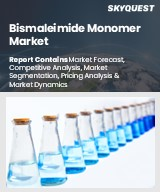
세계의 비스말레이미드 모노머 시장 규모는 2023년에 11억 달러로 평가되며, 2024년 11억 8,000만 달러에서 2032년에는 20억 4,000만 달러로 성장하며, 예측 기간(2025-2032년)의 CAGR은 7.1%로 성장할 전망입니다.
세계 비스말레이미드 모노머 시장은 뛰어난 열적 안정성과 기계적 특성으로 인해 항공우주, 전자, 자동차, 방위산업 등의 산업에서 고성능 복합재료 및 접착제에 필수적인 요소로 자리 잡으며 괄목할 만한 성장세를 보이고 있습니다. 가볍고 내열성이 높은 소재는 항공기 생산에 필수적이기 때문에 항공우주 분야가 매출 점유율을 주도하고 있습니다. 북미는 탄탄한 항공우주 및 방위산업 덕분에 약 40%의 점유율을 차지하며 시장을 독점하고 있습니다. 한편, 아시아태평양, 특히 중국과 인도는 스마트폰 수출을 포함한 산업화와 전자제품 제조 증가로 인해 큰 폭의 성장이 예상됩니다. 그러나 이 시장은 높은 제조 비용과 엄격한 환경 규제라는 문제에 직면해 있습니다. 지속적인 기술 혁신으로 이 부문의 경쟁력은 지속적으로 강화되고 있습니다.
Global Bismaleimide Monomer Market size was valued at USD 1.1 billion in 2023 and is poised to grow from USD 1.18 billion in 2024 to USD 2.04 billion by 2032, growing at a CAGR of 7.1% during the forecast period (2025-2032).
The global bismaleimide monomer market is experiencing remarkable growth, driven by its exceptional thermal stability and mechanical properties, making it crucial for high-performance composites and adhesives in industries such as aerospace, electronics, automotive, and defense. The aerospace sector leads in revenue share, as lightweight and temperature-resistant materials are essential for aircraft production. North America dominates the market with approximately 40% share, thanks to its robust aerospace and defense industries. Meanwhile, the Asia-Pacific region, particularly China and India, is poised for significant expansion due to increased industrialization and electronics manufacturing, including substantial smartphone exports. However, the market faces challenges from high manufacturing costs and stringent environmental regulations. Ongoing innovations continue to enhance competitiveness within the sector.
Top-down and bottom-up approaches were used to estimate and validate the size of the Global Bismaleimide Monomer market and to estimate the size of various other dependent submarkets. The research methodology used to estimate the market size includes the following details: The key players in the market were identified through secondary research, and their market shares in the respective regions were determined through primary and secondary research. This entire procedure includes the study of the annual and financial reports of the top market players and extensive interviews for key insights from industry leaders such as CEOs, VPs, directors, and marketing executives. All percentage shares split, and breakdowns were determined using secondary sources and verified through Primary sources. All possible parameters that affect the markets covered in this research study have been accounted for, viewed in extensive detail, verified through primary research, and analyzed to get the final quantitative and qualitative data.
Global Bismaleimide Monomer Market Segments Analysis
Global Bismaleimide Monomer Market is segmented by Type, Application, End-use and region. Based on Type, the market is segmented into 4,4'-Bismaleimidodiphenylmethane, 2,2-Bis[4-(4-Maleimidophenoxy)Phenyl]Propane, Bis(2-Maleimidoethyl) Disulfide, Bis(3-Ethyl-5-Methyl-4-Maleimidophenyl)Methane, Phenylmethane Maleimide, m-phenylene Bismaleimide, 4-methyl-1,3-phenylene Bismaleimide, 1,6-bismaleimide-(2,2,4-trimethyl)Hexane, BANI-M and Others. Based on Application, the market is segmented into Composites, Adhesives and Others. Based on End-use, the market is segmented into Aerospace, Defense, Electronics and Others. Based on region, the market is segmented into North America, Europe, Asia Pacific, Latin America and Middle East & Africa.
Driver of the Global Bismaleimide Monomer Market
The global Bismaleimide Monomer market is significantly driven by the increasing demand from the aerospace and automotive industries for lightweight and fuel-efficient materials. This growing interest is particularly evident in the use of composites, which are essential in enhancing performance and efficiency. Industries are focusing on advanced materials like 4,4'-Bismaleimidodiphenylmethane for structural components, as they seek to improve overall product design and functionality. As these sectors continue to innovate and push towards more sustainable solutions, the need for high-performance monomers that meet stringent engineering requirements will likely increase, thereby bolstering market growth and opportunities for manufacturers in the global landscape.
Restraints in the Global Bismaleimide Monomer Market
The manufacturing process of bismaleimide monomers involves multiple complex stages, such as the reaction between diamines and maleic anhydride, resulting in a high production cost. This financial barrier limits the feasibility of using bismaleimide monomers in lower-cost applications, such as mass-produced automotive parts, where alternative, more affordable materials are readily available. Additionally, the intricate curing processes required further elevate production expenses, thereby restricting the widespread industrial use of these materials, despite their advantageous thermal stability. Consequently, the high costs associated with manufacturing bismaleimide monomers hinder their adoption in various market sectors.
Market Trends of the Global Bismaleimide Monomer Market
The global Bismaleimide Monomer market is undergoing a significant transformation driven by the increasing emphasis on sustainability and the development of bio-based alternatives. As stringent regulations push manufacturers toward eco-friendliness, companies like Solvay are leading the charge with innovative products, such as their 2024 bio-based CYCOM resins designed for aerospace applications. This trend not only aims to minimize environmental impacts but also capitalizes on the growing demand for sustainable composites across various industries. With consumer preferences shifting towards greener solutions, the market is set to expand, fostering advancements in bio-based materials and driving competitive growth.